North Las Vegas Airport (VGT)
North Las Vegas Airport (VGT) is a primarily general, business, and corporate aviation airport located in the city of North Las Vegas, just northwest of the Las Vegas strip. The larger Harry Reid International Airport is located 8 miles south, and Nellis Air Force Base 7 miles east. North Las Vegas has its own Class Delta airspace that underlies the larger Las Vegas Class Bravo. Pilots should thoroughly review the Airport Diagram and be aware of Hold Short Markings prior to taxiing outbound for departure. View a printable Pilot Handbook of the VGT information found on this Web page.
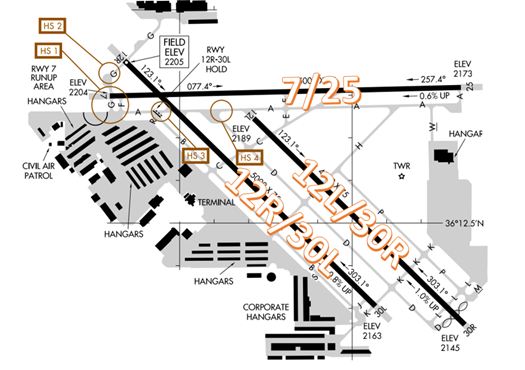
VGT ATCT operates 0600L to 2000L October-March, 0600L-2100L April-September
Administrative Office Open 0700L - 1500L M-F
Business Phone 702-648-6588
The RWY configuration consists of parallel RWYs 12L/30R and 12R/30L along with RWY 7/25.
The airspace at VGT is Class D and underlies the Las Vegas Class B airspace. (Refer to Sectional Chart)
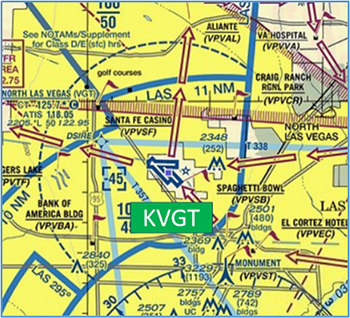
Hot Spots
HS 1: RWY hold lines at TWY G and TWY F in close proximity to edge of large-paved area. Pilots often cross RWY 7 hold line on TWY G without ATC authorization.
- Pilots instructed “RWY 7, taxi via G.” and “RWY 12R, taxi via G, hold short RWY 7” have crossed the hold short line even after acknowledging the taxi instructions. This issue also occurs with aircraft taxied to RWY 7 via TWY F, to a lesser degree.
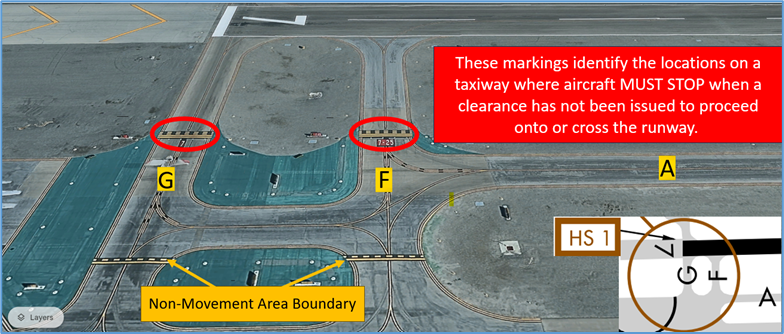
- The area between TWY G and the RWY 7 Runup Area is not visible from the tower. Pilots should review NOTAMS for the Letter to Airmen LTA-VGT-10 “Area Not Visible from the Tower” for more information.
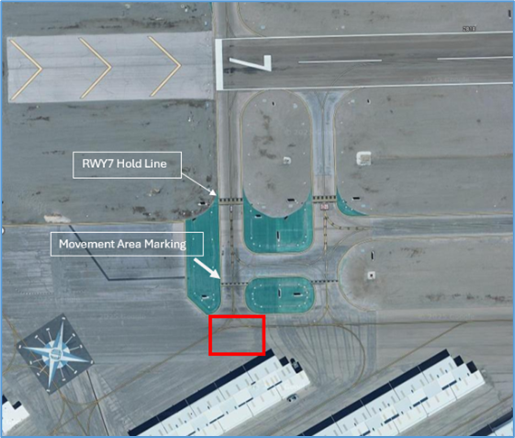
HS 2: Pilots sometimes enter or cross RWY 12R without authorization.
- Pilots taxied to RWY 12R via TWY G have crossed the hold short line despite the presence of signage, surface painted markings and wig-wag lighting.

HS 3: Runway incursion risk. When taxiing to RWY 12R/30L at TWY A via TWY R, the Runway Holding Position Marking for RWY 12R/30L is encountered immediately.

HS 4: Pilots taxiing east on TWY A sometimes fail to hold short of RWY 12L, or neglect to turn onto RWY 12L for departure, instead departing on TWY A.

- For all the above Hot Spot descriptions, pilots should review the taxi clearance before starting to taxi.
- Actively scanning to locate and identify RWY signs, markings, lighting and deferring all heads down activities until holding short at the appropriate location will help eliminate these errors.
- If you are ever unsure of your position or instructions, ask the tower.
Wrong Surface Landing Risk
- Pilots cleared to land on either of the parallel RWYs have landed or attempted to land on the adjacent parallel RWY. See Arrival Alert Notices.
- VGT parallel runways are spaced 700 feet apart (centerline to centerline).
- Offset thresholds exist at each end, requiring heightened spatial awareness.
- Runway End Identifier Lights (REIL) for Runway 12L or 30L will be set to intensity level 3 during daytime parallel runway operations.
- Pilots should review NOTAMS for the Letter to Airmen LTA-VGT-9 “Operational Awareness & Safety Advisory” for specific guidance.
- If available, back up all visual approaches with an instrument approach or GPS Waypoint to help ensure that you are lined up for the correct surface.
- RWY markings are white. Markings on surfaces not used for takeoff/landing like TWY markings, chevrons, RWY shoulder and RWY turn-on markings etc., are yellow.
- View the From the Flight Deck-Wrong Surface Landings video for additional mitigation strategies.
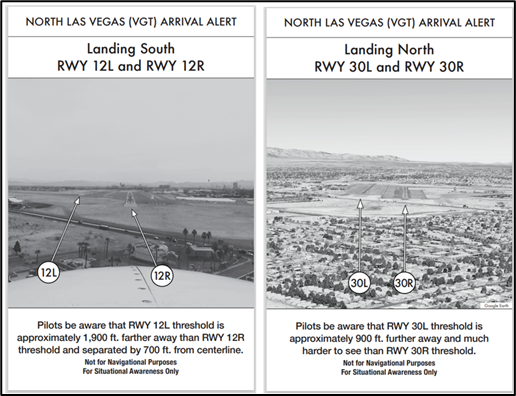
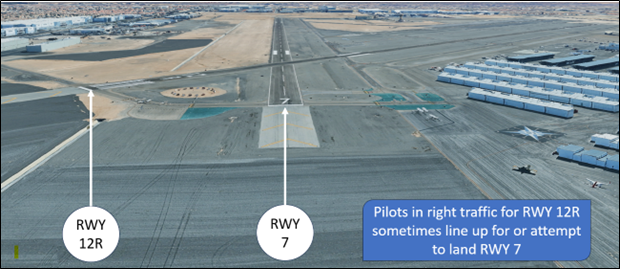
General
- When flying into VGT, be aware the Class D airspace is bordered by Las Vegas Class B airspace, which contains two nearby airports, KLAS and KLSV. This puts VGT in close proximity to high performance aircraft with varying capabilities, so be vigilant of instructions given by ATC.
Clearance Comprehension
- When you receive a clearance from a controller, please ask us for clarification if you do not understand the instruction. Request a suggested heading or alternate instruction if you are unfamiliar. Once you read back a clearance correctly, we receive that as confirmation that you understand the instruction that was issued.
- Air traffic control regulations require a readback of specific instructions. That includes your call sign with the runway assignment, taxiway, and the hold short instructions in the same transmission. Any readback that does not include these requirements will have to be repeated, even if you believe you are the only aircraft on frequency.
Airfield Familiarity
- Prepare for taxi with knowledge of the airfield diagram to reduce confusion and frequency congestion with progressive taxi instructions.
- For occasional runway and taxiway closures, and general information affecting airfield operations, be sure you’re checking the NOTAM system and listening to the ATIS prior to taxiing.
Traffic Patterns
- When in the traffic pattern, there’s a chance you will have to switch frequencies, so be ready to switch to 119.15 when the Tower 2 position is open.
- Be mindful that traffic pattern aircraft speeds are typically 100kts or less, so if there are other aircraft in the pattern, adjust your speed accordingly.
Clearing Movement Areas
- It’s understood that sometimes flight instructors must complete a checklist after landing. Please do not delay compliance with taxi instructions to complete checklists. If you are unable to clear movement areas prior to completing a checklist, please notify the controller that you need to use a run-up area. This will allow other aircraft to continue utilizing airfield movement areas.
- If you need to utilize a run-up area for checklists, airfield familiarization, etc., be sure to notify air traffic when you are ready to continue your taxi.
Runway Crossings
- Controllers will state the active runway when issuing crossing clearances. For example, if you are holding short of RWY 12R at TWY G, the tower controller will state RWY 30L in the crossing clearance if runway 30L is in use. As an example, expect phraseology “N123, cross RWY 30L at TWY G.” This is so you’re aware of where the traffic flow is.
Takeoff/Departure
- All IFR flights departing from VGT should expect the NOTWN SID. The tower will not issue vectors for the departure. Pilots should be prepared to fly the entire SID. Pilots should review NOTAMS for the Letter to Airmen LTA-VGT-8 “Standard Instrument Departure - Compliance Alert” for specific guidance.
- All IFR aircraft departing VGT must have a release coordinated with Las Vegas Approach Control. There may be times when you experience long delays due to sequencing requirements with other IFR traffic in the area.
Fly-by vs. Fly-over
- It has come to our attention that when a pilot is told to proceed direct to a certain point, there may be a 1-mile offset from the point caused by GPS settings. This will result in a fly-by instead of a fly-over. Be aware the controller is expecting you to fly-over that point and proceed accordingly from there.
Frequency Awareness
- We ask that the CFIs maintain radio control when the tower is busy, we understand student training, but inappropriate frequency congestion or lack of responses may interfere with safety.
- Once you’ve exited a runway, please do not immediately switch frequencies unless specifically instructed to do so.
Weather
- VGT weather is on average, clear, and sunny, but high wind gusts and crosswinds are possible.
- During the summer, be aware of the density altitude due to very high temperatures that reach upwards of 120 degrees Fahrenheit.
- There are sporadic thunderstorms in the monsoon season. Be sure to check the local weather forecast and remain vigilant of all weather conditions.
Special Traffic (Military / Commercial / Helicopters)
- There are military UH60 helicopters that fly instrument practice approaches from time to time, doing high speeds.
- There is a frequently used VFR practice area northwest of VGT. Pilots utilizing this area should make their best effort to avoid the extended centerline of RWY 12R/30L when operating in the area. The final approach course for IFR aircraft inbound to VGT from the northwest follows the extended centerline of RWY 12R/30L. Inbound IFR pilots rarely monitor or transmit on the practice area frequency.
